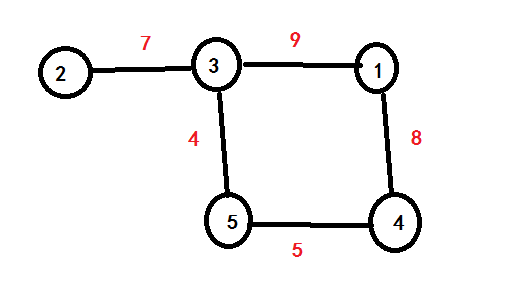In the Kingdom K., there are n towns numbered with integers from 1 to n. The towns are connected by n bi-directional roads numbered with integers from 1 to n. The i-th road connects the towns ui and vi and its length is li. There is no more than one road between two towns. Also, there are no roads that connect the towns with itself.
Let's call the inconvenience of the roads the maximum of the shortest distances between all pairs of towns.
Because of lack of money, it was decided to close down one of the roads so that after its removal it is still possible to reach any town from any other. You have to find the minimum possible inconvenience of the roads after closing down one of the roads.
The first line contains the integer n (3 ≤ n ≤ 2·105) — the number of towns and roads.
The next n lines contain the roads description. The i-th from these lines contains three integers ui, vi, li (1 ≤ ui, vi ≤ n, 1 ≤ li ≤ 109) — the numbers of towns connected by the i-th road and the length of the i-th road. No road connects a town to itself, no two roads connect the same towns.
It's guaranteed that it's always possible to close down one of the roads so that all the towns are still reachable from each other.
Print a single integer — the minimum possible inconvenience of the roads after the refusal from one of the roads.
3
1 2 4
2 3 5
1 3 1
5
5
2 3 7
3 1 9
4 1 8
3 5 4
4 5 5
18
题意 :
给定n个点 n条边 (保证联通 ,边无向 ,无重边 ,无自环)
断掉某条边以后 保证联通的情况下,图上有一条最长路
求最长路的最小值
思路 :
n个联通的点 n条边
即 树上多了一个环
断掉的边只能在环上
所以 题意转化为 从环上断掉一个点以后 树上直径的最小化
首先 dfs 找出环
然后得到非环上边的最长路(求以环上点为根的子树直径)
之后得到环上点到其子树的最长路 记为 点 i 的权值 val [ i ]
样例二:

得到 当前最长直径是 点 3 的子树 长度为 7 记录下来为 L1 (我在这里错了几次)
得到每个点的权值
val [ 1 ] = 0
val [ 3 ] = 7
val [ 4 ] = 0
val [ 5 ] = 0
然后得到环上的 前缀路径和 与后缀路径和
point 1 -> 3 -> 5 -> 4 -> 1 -> 3 -> 5 -> 4
road 9 4 5 8 9 4 5
pre- > 0 9 13 18 26 35 39 44 ->
suf <- 44 35 31 26 18 9 5 0 <-
然后 容易知道 到点 i 的 “前缀和”+ “点权值” (pre [ i ] + val [ i ]) 表示 环上第一个点(上图中为1)到 i 的 子树的最长路径
由于 “树上 离任意一点最远的一定是 直径的某个端点”
这样由区间最大值就可以得到 一个直径端点 然后往 “前面” 和 “后面” 找到 离端点最远的另一个点 就是直径的第二个端点
每次的区间大小为环的长度 (表示断掉一条边以后的路径前缀和) 每次向右移动一次 得到 第二个直径 并更新 ans
区间最大值的维护可以通过线段树 维护一个前缀的 一个后缀的
最后答案输出 max(ans,L1) 即可
1 #include <bits/stdc++.h> 2 3 #define mp make_pair 4 #define pb push_back 5 #define lson l,mid,pos<<1 6 #define rson mid+1,r,pos<<1|1 7 #define fi first 8 #define se second 9 10 using namespace std; 11 12 typedef long long LL; 13 typedef pair<long long ,int> pli; 14 15 const long long INF = 0x3f3f3f3f3f3f3f3f; 16 17 vector <int > nt[423456]; 18 vector <int > cc[423456]; 19 int noloop[423456]; 20 int cnt[423456]; 21 LL val[423456]; 22 LL toval[423456]; 23 LL id[423456]; 24 int idfrm[423456]; 25 pli tree1[420000<<2]; 26 pli tree2[420000<<2]; 27 LL pre[423456]; 28 LL suf[423456]; 29 int mark=1; 30 LL zz010=0; 31 void dfs1(int x,int fa) 32 { 33 noloop[x]=1; 34 for (int i=0;i<nt[x].size();i++){ 35 if (fa==nt[x][i])continue; 36 cnt[nt[x][i]]--; 37 if (cnt[nt[x][i]]==1)dfs1(nt[x][i],x); 38 } 39 } 40 LL dfs2(int x,int fa) 41 { 42 LL ret=0; 43 LL ret2=0; 44 for (int i=0;i<nt[x].size();i++){ 45 if (fa==nt[x][i]||noloop[nt[x][i]]==0)continue; 46 LL tmp=dfs2(nt[x][i],x)+cc[x][i]; 47 if (tmp>ret){ 48 ret2=ret; 49 ret=tmp; 50 }else if (tmp>ret2)ret2=tmp; 51 } 52 zz010=max(zz010,ret+ret2); 53 return val[x]=ret; 54 } 55 void dfs3(int x,int fa) 56 { 57 idfrm[mark]=x; 58 id[x]=mark; 59 for (int i=0;i<nt[x].size();i++){ 60 if (noloop[nt[x][i]]||nt[x][i]==fa||id[nt[x][i]])continue; 61 toval[mark++]=cc[x][i]; 62 dfs3(nt[x][i],x); 63 return ; 64 } 65 for (int i=0;i<nt[x].size();i++){ 66 if (id[nt[x][i]]!=1)continue; 67 toval[mark]=cc[x][i]; 68 return ; 69 } 70 } 71 void push_up(pli tree[],int pos) 72 { 73 tree[pos]=max(tree[pos<<1],tree[pos<<1|1]); 74 } 75 void upd(pli tree[],int l,int r,int pos,int x,long long val) 76 { 77 if (l==r){ 78 tree[pos].fi=val; 79 tree[pos].se=x; 80 return ; 81 } 82 int mid=(l+r)>>1; 83 if (x<=mid)upd(tree,lson,x,val); 84 else upd(tree,rson,x,val); 85 push_up(tree,pos); 86 } 87 pli query(pli tree[],int l,int r,int pos,int l1,int r1) 88 { 89 if (l1>r1)return mp(-INF,0); 90 if (l>=l1&&r1>=r){ 91 return tree[pos]; 92 } 93 pli mx=mp(-INF,0); 94 int mid=(l+r)>>1; 95 if (mid>=l1)mx=query(tree,lson,l1,r1); 96 if (mid+1<=r1)mx=max(mx,query(tree,rson,l1,r1)); 97 return mx; 98 } 99 int main() 100 { 101 int n; 102 scanf("%d",&n); 103 int a,b; 104 long long v; 105 for (int i=0;i<n;i++){ 106 scanf("%d%d%I64d",&a,&b,&v); 107 nt[a].pb(b); 108 nt[b].pb(a); 109 cc[a].pb(v); 110 cc[b].pb(v); 111 cnt[a]++; 112 cnt[b]++; 113 } 114 for (int i=1;i<=n;i++){ 115 if (nt[i].size()==1)dfs1(i,-1); 116 } 117 for (int i=1;i<=n;i++){ 118 if (noloop[i]==0)dfs2(i,-1); 119 } 120 for (int i=1;i<=n;i++){ 121 if (!noloop[i]){ 122 dfs3(i,-1); 123 break; 124 } 125 } 126 long long tmp=0; 127 for (int i=1;i<=mark;i++){ 128 idfrm[i+mark]=idfrm[i]; 129 toval[i+mark]=toval[i]; 130 } 131 toval[0]=toval[mark]; 132 for (int i=1;i<=2*mark;i++){ 133 pre[i]=pre[i-1]+toval[i-1]; 134 upd(tree1,1,2*mark,1,i,val[idfrm[i]]+pre[i]); 135 } 136 for (int i=2*mark;i>=1;i--){ 137 suf[i]=suf[i+1]+toval[i]; 138 upd(tree2,1,2*mark,1,i,val[idfrm[i]]+suf[i]); 139 } 140 LL ans=INF; 141 int flag=0; 142 for (int i=1;i<=mark;i++){ 143 pli now_mx=query(tree1,1,2*mark,1,i,i+mark-1); 144 pli tmp1=query(tree1,1,2*mark,1,now_mx.se+1,i+mark-1); 145 pli tmp2=query(tree2,1,2*mark,1,i,now_mx.se-1); 146 LL dis1=0LL,dis2=0LL,dis3=0,dis4=0; 147 if (tmp1.se!=0)dis1=val[idfrm[now_mx.se]]+val[idfrm[tmp1.se]]+pre[tmp1.se]-pre[now_mx.se]; 148 if (tmp2.se!=0)dis2=val[idfrm[now_mx.se]]+val[idfrm[tmp2.se]]-pre[tmp2.se]+pre[now_mx.se]; 149 ans=min(ans,max(dis1,dis2)); 150 }151 cout<<max(ans,zz010); 152 return 0; 153 }
最后 数组记得开大点 前缀和与后缀和 为 环上点数量的两倍